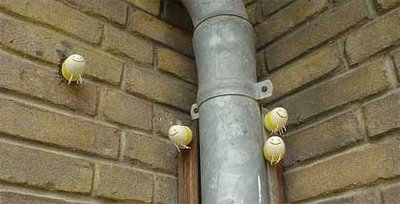We Make Money, Not Art files a great report about Sara and Marc Schiller from Wooster Collective, who presented at the Conflux Festival in Brooklyn, NY.
The title of their talk was "What is it about street art that inspires us?" What inspires them has no particular set of rules nor well-defined criteria, it's an "emotional thing." The talk tried to break down the DNA of street art, without pretending to be a dogma or a text book, it's just the gathering of their thinking of two persons who've been following and documenting very closely the street art scene since 2001.
3 critical ingredients of street art:
1. Location, location, location!
It has to be illegal. A work of street art reclaims the public space and the best street art has a context, builds a relationship with its environment, dialogs with the city. Most of the artists document their work on the web. It doesn't mean that street art is meant to be seen on the web. The art has to be left in the street where it might stay for months or just half an hour. Most of the pieces are one-off.
2. Surprise and delight
The works tap into our emotions and we get that WTF ??? moment. The web cannot recreate that experience but it's still important to document the works on the internet because not everybody gets the opportunity to see one of Banksy's works. Besides, half of the passersby might walk by the work and totally ignore it. Creating surprise and delight doesn't require a particular skill or training, it's more a matter of ingenuity and brillance.
Above, the "Crate Man" in Melbourne
"Embeds" series by tape artist Mark Jenkins.
3. Have something to say
A statement on how you see the world, the best pieces do not necessarily make a strong political statement but they will make you see the city under a different light. Artists let passersby make their own interpretation of the work. Half the people pass by and might never see it though.
A knitted, pink cosy for a tank of the Danish Army. Knitted by Marianne Joergensen plus some 1000 volunteers
4. Personal and intimate
The pieces are very subjective. It takes time, commitment and money to craft works (most of the pices are hand-made and one-offs) that might disappear nearly as soon as they have been left in public space, street art can therefore hardly be regarded as vandalism. Once you leave a piece in the streets, you don't own it any more and have no control over it, it belongs to the street. Besides all the pieces change over time, because of the elements and the weather. 
Little bees in a backyard in Amsterdam.
Share ideas that inspire. FALLON PLANNERS (and co-conspirators) are freely invited to post trends, commentary, obscure ephemera and insightful rants regarding the experience of branding.
Monday, October 02, 2006
Culture: Wooster Collective @ Conflux
Subscribe to:
Post Comments (Atom)















No comments:
Post a Comment